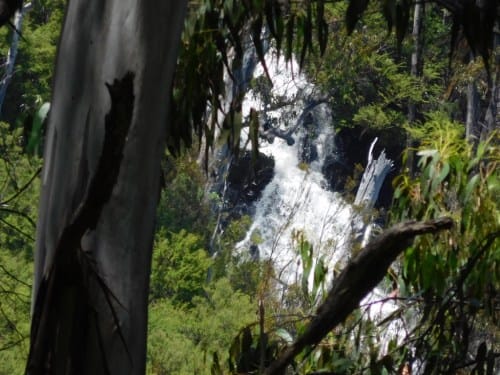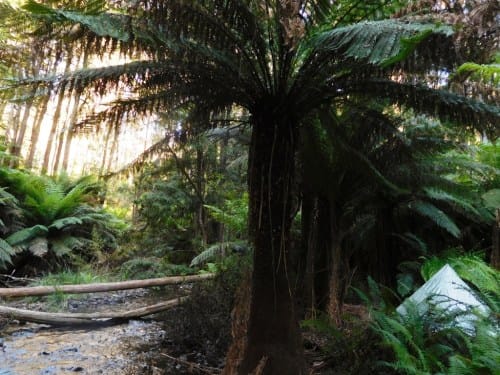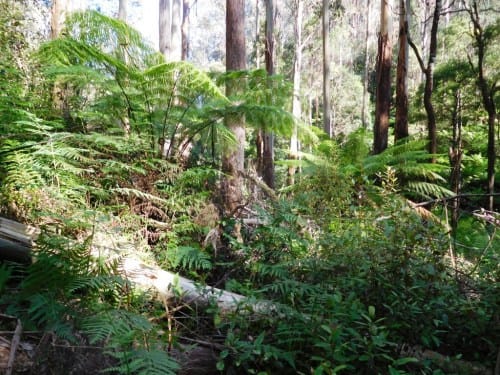THE FAR UPPER YARRA.
By A. J. CAMPBELL.
REMARKABLE FALLS.
Except to a few surveyors, occasional prospectors, tourists, or opossum-hunters, the region of the Upper Yarra is un-known. Hoddle surveyed the locality in 1843, and in 1890 the Mining department cut a track from Walsh's Creek along the river to Mount Baw Baw. Possibly that is all that has been done officially.
For years I had desired to ascend to the fountain-head of the Yarra, and the chance came recently, when a party of four, con-sisting of a surveyor, a Gippsland bushman, a field naturalist, and a photographer, undertook the trip.
The junction of Walsh Creek with the Yarra, 67 miles from town, is easily reached by rail and coach in one day. We put up at McVeigh's Upper Yarra Hotel, on the direct road to Wood's Point, wher it com mands a view of a fine flat in the fork of the two streams, at an elevation of 1,000 ft.
above sea level.
At 7 a.m. next day we leave McVeigh's, with an addition of two to our party- a pack-horse and his owner. We need the horse to carry a tent and provisions for a week, and the own to look after it. The track leads along the South side of the river, and is high enough to enable us to look down on the stream, bordered with fine ferns, and running swiftly over a rocky bed. Heavily timbered ranges rise from the opposite side. On our side, on a narrow flat, are some whitegums, 200ft., by actual measurement, in height. At half-past 9, several miles from Walsh Creek we reach Contention Creek. Why so-called we could not ascertain. We
unpack our camera to photograph "the highest habitation on the Yarra." There is a gold-mining claim, yielding payable gold.
The occupant of the hut welcomes us with bush hospitality, and the billy is soon on the fire.
After an hours spell, we dive in single
file into the forest. At first the way,al-though overgrown, is tolerably good, but
when we descend into the gullies, and get enveloped in thick scrub, we find the go-ing difficult. Our packhorse, save when bumping his load against a tree, or when grunting loudly on the steep pinches, be-haves splendidly, and mile by mile we move along the mountain sidelings, while the river is heard below, though lost to sight
in thickets. Not only are we getting smothered in timber, but the mountains appear to be converging. On the opposite
side ocasionally a valley densely timbered,
opens, denoting that some tributory comes down to join the main stream. It is re-
freshing to descend, when we get a little warm, into the beds of rivulets, to rest under ferns, protected by groves of sassafras and beech. We slowly but
surely forge our way along through the forest, enlivened by the voices of a few birds-lyre birds, cockatoos, and parrots.
Three snakes are seen but only one is de spatched. We sight a blazed tree on a
steep sideling. "Ah", says the pack horse owner, "this must be where the last party lost their packhorse. They said they blazed the place." We shudder when we gaze down and wonder what we should do should our horse topple over with tent and tucker, and disappear among the vegeta-tion far below. Our experience came on the return journey, when our horse fell twice, and nearly rolled into the river.
Abut 4 o'clock, when getting weary, we break suddenly upon a spledid stream. It is Falls Creek, where we pitch our camp. We endulge in mutual congratula
tions over our safe arrival.
A circular flat is selected for the camp-a most charming and picturesque spot, encl osed by tree ferns, presided over by stout
stemmed beeches. Between tent and stream is just space for a table and a fire-place. Ferny beds are made, and we feel exceedingly happy and snug when enjoying our evening meal. High ranges, clothed with vegetation, wall us in completely. The world is shut out, and we are alone, with the silence broken only by the sound of the running waters, and the rustling of the leaves when they are stirred by wander
ing airs.
The business of next day is to explore
the creek from it's junction with the Yarra to the top of the falls. Where the junc tion occcurs, a hundred yards below our camp, the Yarra comes in seven
paces wide, from the eastward, and the Falls Creek, with one third less volume, from the southeast. Crystalline waters meet on a shingly bed, ferns lending charm to the scene, and we get a lovely picture
for the camera. The height above sea level is approximately 1,770ft. Keeping to the
rocky bed of the stream, which is choked with logs, we gradually ascend. We arrive at a pretty vista, opened up by the fall of trees which have cleared an opening along
the creek bed. On our left is a wall of ve
getation, chiefly beech, gilded on top with sunshine. At 11 a.m., after rounding a bend, and brushing aside overhanging fronds, we catch a sight of the lowest fall. The water descends in a leap of about 70ft.
and spray from it is wafted upon us like
"scotch mist". It needs no small effort
on our part to climb over friable earth and large flat stones to the head of the fall.
Shortly afterwards we catch sight of a second fall. Before we attempt to renew the climbing process we sit down in full view of an interesting scene to lunch.
When again on the move upwards, we find the climbing harder work than ever. It may even be said to be dangerous. As soon as the second fall is conquered, a third
appears, and beyond it a fourth. Perspir ing freely, we climb on, laying hold of rocks, tree stems, and tufts of grass to pull our selves up. As we rise, we notice that the scrub is thinning, and that the big trees are eucalypts, sure signs that we are passing from the region of moisture on to compara bly dry levels. Near the top we encoun ter an outcrop of silurian rock, with all the slate-like strata verticle. Where the falling stream meets the rock it is diverted at right angles and drops50ft. down a gulch. We surmounted six falls in all, and were not sorry when we came to the upper
most for we found ourselves almost
"played out". Though we started early in the morning, we did not reach the summit till late in the afternoon. At the sixth, or top fall the stream is divided by rocks. It descends for a little distance in two branches which eventually meet in the sas
affras below. Our aneroids indicate that we have seen 1,000ft. since the morning. Be
tween the first fall and the last we jump 700ft. in about one-fifth of a mile, their length being all told.
Our surveyor picks up the old Baw Baw track, by which we descend the sharp
spur dividing the Yarra proper from Falls Creek, and we arrive in camp in an hour.
When the track from Contention Creek to Falls Creek, a distance of about 11 miles,
is reopened, a new and interesting route will be available for tourists to one of the most romantic regions in Victoria, only two days travelling from Melbourne under pre
sent conditions.
AN UPLAND RAMBLE
On a subsequent day we explored the range above our camp. Starting early we
ascended 1,000ft. by the track which had brought us down from the summit of the falls. The upper levels, above the scrub,
were covered with big eucalypts and tall grass. We headedeasterly, and soon got into beech timber, mixed with sassafras. The "forest floors" are carpeted with stiff Cape lomaria ferns, knee high, with fronds of sepia tint, very striking when seen
against the sunlight streaming through the trees. We come to a huge dead eucalypt, with a hollow stem. The temptation to set it on fire is too great for the bushman, who puts a lighted match to a handful of dry ferns. With so much moisture and green wegetation everywhere there is no danger of starting a bush fire. The chimney imme diately began to smoke and roar. Or path is very scrubby and obscure in places,
but the surveyour and bushman, who take the lead in turns, keep to it instintively.
Our travelling is slow-about a mile and a half an hour- through our having to step high over logs. Sometimes we brush through scrub bearing white star flowers, and the vegetable dust shaken off as we pass sets up irritating coughs. In a sunbeam we could distinctly see the dust when the scrub was shaken. The plant is called "choke" bush (Aster stellulatus).
When we are fairly in the beech forest
avenues of magnificent trees open up in every direction. Their stems are bedecked with moss and lichen, and they bear masses of dark green foliage. The track we are on cuts the line from Noojee to Aberfeldy,
one of Whitelaw's early tracks; but we keep our own, passing a signboard on a tree marked "To the Yarra Head". We come to a gumtree ridge, occupied with immense trees, and observe one or two black cocka toos, some gang-gang cockatoos, and a family
of handsome King parrots. The scrub cheifly consists of a dwarf "Christmas" tree,
or Prostanthera. Both flowers and foliage diffuse around a heavy perfume. Then we arrive at a tiny hill and an outcrop of granite, at an altitude of 2,000ft. above sea level. After that we pass through acres
upon acres of fine, tall eucalypts, standing as close together as they can grow, straight stemmed, shooting skyward from 100ft. to 150ft. This wealth of timber is known to extend along the ridge for 10 or 11 miles. Once we are properly in the granite country the vegetation changes to acacias (silver wattle, &c.), pittosporum, native hazel, leatherwood, &c. "Penny"
Creek we so name because we drove a nail through a coin to fasten it to a hazel tree.
At midday, about seven miles from camp, we strike the Yarra again. It is now only five paces wide, and eighteen inches deep,
and it runs leisurely over a sandy bottom sparkling with specks of mica. The source of the stream is only five miles higher up, in a plateau.
We are astonished to find a bridge, a tolerably substantial structure, too. There fore we take a photograph, entitling it the
"Highest Bridge Over The Yarra". At this Altitude (3,120ft. above the sea), our natur-alist finds many interesting plants, includ-ing a white oxalis and a small Alpine lomaria. While photographing and botanising were proceeding, the surveyor pushed along the
"T" track, encountering much fallen tim-ber, and reached the Tanjil track at over 4,000ft. Turning south-west along it, and passing the "14-mile tree", he struck the Yarra for the last time. Here at 3,160ft.,
it is only two paces wide, descending by a depression from the base of Mount Baw Baw, whose rounded crest could be plainly discerned three or four miles away, backed by a great billowy cloud, while above all was the ethereal blue. Following the stream down with difficulty for about two miles, the surveyor reached the bridge where we were, and we all returned to camp, which was reached about 6 o'clock.
The fewness of the birds surprised us. We niether heard nor saw magpies above Walsh Creek, and very few laughing jack-asses. In the beech forest we heard the pretty rose-breasted and pink-breasted robins. We saw a few pairs of flame-breasted robins on the saddles of the range.
A lyre-bird entertained us there, whistling near our camp. We noticed many lyre-bird dancing-grounds in the gullies and in the open scrub among the tall gums. There appear to be no fish in the
streams.
Of plants we made an interesting collec tion, some 300 specimens, representing about half that number of species. A yellow flowering tree, Daviesia, attracted us much on the ridges. Near Walsh Creek we came
across a patch of about five acres of boronia (B. pinnata), with small but sweetly-scented foliage and tiny pinkish flowers. Subse-quently, on our submitting a sample of the shrub to a perfumory chemist, he reported that it yielded enough essential oil to have a commercial value.
We tried to find Hoddle's marked tree, " 1843", near our camp, but failed. Wear and tear for well-nigh threescore years had no doubt obliterated it.






 RSS Feed
RSS Feed
